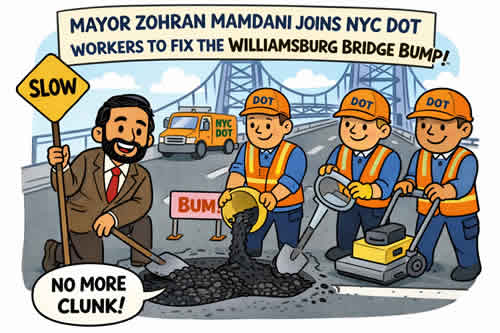New York Governor Kathy Hochul today provided an update on the winter storm that dropped more than a foot of snow in some locations north of New York City and continued to impact several areas with hazardous travel conditions. The highest accumulations of snow have been seen so far in the Mid-Hudson Region with some locations receiving as many as 14 inches of snow. Governor Hochul also urged New Yorkers to prepare for the next winter storm, a high precipitation weather event forecasted to hit New York on Tuesday afternoon.
Governor Hochul also warned New Yorkers of another storm system that is expected to affect the state Tuesday and Wednesday with snow, heavy rain and high winds, which could worsen travel conditions and produce flooding in some locations. The heavy rain and snowmelt are expected to result in river flooding, as well as localized urban and poor drainage flooding. In addition, sustained winds accompanying the system could reach up to 45 mph in some places, and 65-70 mph gusts, especially in areas adjacent to Lake Ontario.
“We have seen snow accumulations across the State and with more on the way we are keeping a close eye on potential impacts throughout the day – I urge New Yorkers to stay vigilant and practice caution, especially if you need to travel,” Governor Hochul said. “We are also tracking another potentially severe storm system that could bring several inches of rain and possible flooding to some areas of the State starting Tuesday. I have directed State agencies to closely monitor this weather system and they are prepared to provide assistance to our partners at the county level if necessary.”
High Wind Watches are in effect starting Tuesday and continuing into Wednesday for parts of Western and Central NY, the Finger Lakes, and the North Country regions. Sustained winds are expected to reach up to 45 mph in some places and gusts as high as 65-70 mph, especially for areas adjacent to Lake Ontario, including Jefferson, Lewis and Oswego counties.
For a complete listing of weather alerts and forecasts, visit the National Weather Service website at https://alerts.weather.gov. New Yorkers are also encouraged to sign up for emergency alerts by subscribing to NY Alert at https://alert.ny.gov, a free service providing critical emergency information to your cell phone or computer.
Agency Activities
New York State Division of Homeland Security and Emergency Services
The Division is actively monitoring the weather forecast and coordinating the State’s response to the weather event. Office of Emergency Management staff are in contact with local counterparts and are prepared to facilitate requests for assistance. The Division is prepared to deploy emergency response assets and shelter supplies from the State’s stockpiles.
New York State Department of Transportation
The State Department of Transportation is responding to the current weather event with nearly 3,700 supervisors and operators available statewide. All residencies in impacted locations will remain staffed for 24/7 operations with operators, supervisors, and mechanics throughout the duration of the event and priority cleanup operations. To support snow and ice activities in critical areas, 30 staff including nine plow truck operators and 21 equipment operator instructors were deployed from other regions to the Capital Region and Mid-Hudson Region.
Statewide equipment numbers are as follows:
- 1,617 large plow trucks
- 149 medium duty plows
- 52 tow plows
- 343 large loaders
- 36 snow blowers
Tow services will be provided in the following locations: I-81 (Broome), I-88 (Broome), I-86 (Broome), NY 17 (Broome), NY 206 (Delaware), NY 17 (Sullivan), I-84 (Putnam), I-84 (Orange), and I-684 (Putnam). The need for additional tow services will be evaluated as the event continues to develop.
For real-time travel information, motorists should call 511 or visit https://www.511ny.org or the mobile site at m.511ny.org, New York State’s official traffic and travel information source.
Thruway Authority
Thruway Authority staff are actively engaged in snow and ice activities and responding to the storm with 700 plow operators and supervisors statewide. Maintenance facilities are fully staffed and ready to shift resources as necessary. Prior to the storm, the Thruway Authority deployed staff and equipment from its Buffalo Division to support snow and ice operations in the Mid-Hudson Valley region. Deployed resources include large plow trucks and plow operators. In addition, Emergency Operation Centers (EOC) are open in impacted regions for the duration of the storm.
Variable Message Signs and social media are utilized to alert motorists of winter weather conditions on the Thruway.
The Thruway Authority encourages motorists to download its mobile app which is available for free on iPhone and Android devices. The app provides motorists direct access to real-time traffic information, live traffic cameras and navigation assistance while on the go. Motorists can also sign up for TRANSalert e-mails and follow @ThruwayTraffic on X for the latest traffic conditions along the Thruway.
New York State Department of Public Service
Utility companies regulated by the Department of Public Service have approximately 5,550 workers available statewide to engage in repair and restoration efforts for the winter weather system. This includes 50 external workers secured by Orange and Rockland Utilities. DPS staff will continue to track utilities’ work throughout the event and ensure utility companies continue to shift appropriate staffing to regions that experience the greatest impact. If your service is interrupted, visit the DPS Utility Service Interruptions website for tips.
New York State Police
State Police are monitoring weather conditions and are prepared to deploy additional Troopers as needed. All State Police four-wheel drive and specialized vehicles, including snowmobiles and utility terrain vehicles, are staged and ready for immediate response, and all emergency power and communications equipment has been tested.
“We have seen snow accumulations across the State and with more on the way we are keeping a close eye on potential impacts throughout the day – I urge New Yorkers to stay vigilant and practice caution, especially if you need to travel.”
Governor Kathy Hochul
New York State Department of Environmental Conservation
DEC Emergency Management staff, Environmental Conservation Police Officers, Forest Rangers, and regional staff remain on alert and continue to monitor the developing situation and weather forecasts. All available assets are positioned to assist with any emergency response.
DEC reminds those responsible for the large-scale removal and disposal of snow to follow best management practices to help prevent flooding and reduce the potential for pollutants like salt, sand, oils, trash, and other debris in snow from affecting water quality. Disposal of snow in local creeks and streams can create ice dams which may cause flooding in nearby areas. Public and private snow removal operators should be aware of these safety issues during and after winter storms. Additional information is available at https://extapps.dec.ny.gov/docs/water_pdf/togs5111new.pdf.
New York State Office of Parks, Recreation and Historic Preservation
New York State Park Police and park personnel are on alert and closely monitoring weather conditions and impacts. Response equipment is being fueled, tested, and prepared for storm response use. Park visitors should check https://parks.ny.gov or call their local park office for the latest updates regarding park hours, openings and closings.
Metropolitan Transportation Authority
The Metropolitan Transportation Authority (MTA) continues its agency preparation and responses for the first snowfall of 2024 and rain expected across its transportation network. All agency preparations were launched to ensure customer and employee safety while delivering as much reliable service as possible through the storm.
MTA personnel and equipment has been placed across the network, including spreading salt and clearing surfaces of snow, keeping signals, switches, and third rails operating, and attending to any weather-related challenges.
Metro-North Railroad
Metro-North strategically deployed its snow-fighting equipment at facilities across the system, including counties most impacted by the storm, including:
- Electric trains being outfitted with special third rail shoes to prevent snow from accumulating.
- Air brake lines purging any moisture on the tracks to prevent freezing. Protective heat circuits were verified to be operational.
- Electric switch heaters are being used at interlocking tracks to melt snow.
New York City Transit
More than 2,100 New York City Transit personnel are on duty for this weekend’s storm. While underground portions of the subway system remain unaffected during rain and snowstorms, the agency is mindful of the nearly 220 miles of outdoor track throughout the boroughs. New York City Transit’s Department of Subways deployed a fleet of emergency response equipment including emergency trucks, pump trains, de-icer trains, and debris trains to deploy and respond to flooding or icy conditions. New York City Transit’s Department of Buses is monitoring routes for known flooding situations, have prepared detours, and personnel are ready in the event of subway service disruptions.
MTA Bridges and Tunnels
MTA Bridges and Tunnels personnel activated full inclement weather preparedness for all facilities and the Operations Command Center Weather Desk continues to monitor the forecast. MTA Bridges and Tunnels are equipped with almost 9,600 tons of roadway de-icer and 115 pieces of equipment. Bridges are equipped with embedded roadway sensors which measure temperature and above-ground atmospheric sensors that deliver real-time information on wind velocity, wind direction, humidity and precipitation via wireless communication. Restrictions may be put in place if weather conditions warrant.
Long Island Rail Road
The Long Island Rail Road has snow-fighting trains, tow trucks and de-icers ready to protect tracks and switches. LIRR has hundreds of extra personnel to sand and salt platforms, stairs, driveways, and walkways. Personnel will survey and clear drainage areas where necessary, fortify key locations as well as any track structures requiring attention. Crews have equipment to respond quickly as conditions warrant, including chainsaws for clearing downed trees, pumps in the event of flooding, and can identify locations and availability of supplies for replacing damaged utility poles and crossing gates.
Access-a-Ride
Access-A-Ride paratransit will continue to provide service. Paratransit Command Center will be monitoring the storm to track and respond to any customer or day of service issues.
For the latest updates on service across the MTA transportation network, check out the MTA website and our various apps – MyMTA and Train Time – plus, our social media channels.
Port Authority
The Port Authority monitors weather conditions across all its facilities. In the event of severe weather conditions, the agency issues regular travel alerts and updates as needed. For the latest information about Port Authority facilities, please check social media, sign up for PA alerts or download one of the PA mobile apps, including RidePATH, which provides real-time updates and alerts for PATH service.
Safety Tips
Travel
Some of the most important tips for safe driving include:
- Do not drive unless necessary.
- If you must travel, make sure your car is stocked with survival gear like blankets, a shovel, flashlight and extra batteries, extra warm clothing, set of tire chains, battery booster cables, quick energy foods and brightly colored cloth to use as a distress flag.
- If you have a cell phone or other communications device such as a two-way radio available for your use, keep the battery charged and keep it with you whenever traveling. If you should become stranded, you will be able to call for help, advising rescuers of your location.
- The leading cause of death and injuries during winter storms is transportation accidents. Before getting behind the wheel, make sure that your vehicle is clear of ice and snow; good vision is key to good driving. Plan your stops and keep more distance between cars. Be extra alert and remember that snowdrifts can hide smaller children. Always match your speed to the road and weather conditions.
- It is important for motorists on all roads to note that snowplows travel at speeds up to 35 mph, which in many cases is lower than the posted speed limit, to ensure that salt being dispersed stays in the driving lanes and does not scatter off the roadways. Oftentimes on interstate highways, snowplows will operate side by side, as this is the most efficient and safe way to clear several lanes at one time.
- Motorists and pedestrians should also keep in mind that snowplow drivers have limited lines of sight, and the size and weight of snowplows can make it very difficult to maneuver and stop quickly. Snow blowing from behind the plow can severely reduce visibility or cause whiteout conditions. Motorists should not attempt to pass snowplows or follow too closely. The safest place for motorists to drive is well behind the snowplows where the roadway is clear and salted. Never attempt to pass a snowplow while its operating.
Power Outages
- Check with your utility to determine area repair schedules.
- Turn off or unplug lights and appliances to prevent a circuit overload when service is restored; leave one light on to indicate when power has been restored.
- If heat goes out during a winter storm, keep warm by closing off rooms you do not need.
To Report an Electric Outage, Call:
- Central Hudson: 800-527-2714
- Con Edison: 800-752-6633
- National Grid: 800-867-5222
- NYSEG: 800-572-1131
- O&R: 877-434-4100
- PSEG-LI: 800-490-0075
- RG&E: 800-743-1701
Heating Safety
- Use only safe sources of alternative heat such as a fireplace, small well-vented wood or coal stove or portable space heaters.
- When using alternative heat sources such as a fireplace, woodstove, etc. always make sure you have proper ventilation. Always follow manufacturer’s instructions.
- Keep curtains, towels, and potholders away from hot surfaces.
- Have a fire extinguisher and smoke detectors and make sure they work.
- If you use kerosene heaters to supplement your regular heating fuel, or as an emergency source of heat, follow these safety tips:
- Follow the manufacturers’ instructions.
- Use only the correct fuel for your unit.
- Refuel outdoors only and only when the unit is cool.
- Keep the heater at least three feet away from furniture and other flammable objects.
- When using the heater, use fire safeguards and ventilate properly.
- Follow the manufacturers’ instructions.
Albany New York January 7 2024
SOURCE:governor.ny.gov – Midtown Tribune news
Big New York news










